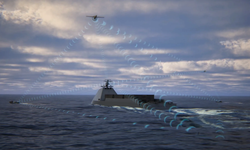GE Aerospace has renewed its cooperation with the Royal Australian Navy (RAN), marking ten years of partnership and extending its Comprehensive Support Agreement (CSA) for LM2500 marine gas turbine engines through 2029, with options to extend until 2039.
The agreement covers maintenance, logistics, and technical support for 16 LM2500 engines powering three classes of RAN vessels (the Anzac-class frigates), Hobart-class destroyers, and Canberra-class landing helicopter docks. The partnership, now approaching three decades, ensures continued propulsion system support both at sea and onshore.
Under the CSA, GE Aerospace will provide 24/7 technical support, overhaul and maintenance of propulsion systems, spare parts management, field services, configuration oversight, and training for RAN personnel. Over the past decade, the fleet has maintained an average availability rate of 99.9 percent.
Lisa Wade, General Manager of GE Aerospace’s Marine & Mobility Engines, said:
“Celebrating 10 years of partnership with the Royal Australian Navy is a testament to GE Aerospace’s commitment to delivering dependable power and ensuring their ships are mission-ready. This extended partnership ensures seamless interoperability through shared operations, maintenance, and supply systems - critical advantages for allied naval cooperation.”
GE’s LM2500 turbines currently power six engines on three Hobart-class destroyers, seven engines across Anzac-class frigates, and one engine each on the two Canberra-class landing helicopter docks.
Beyond marine propulsion, GE Aerospace supports nearly 400 engines in service and on order across the Australian Defence Forces, powering aircraft such as tankers, fighter jets, and attack helicopters. The company’s Brisbane facility, opened in 2022, provides maintenance for avionics, power, and propeller systems used on both military and commercial platforms.
📌 GE Aerospace extends its partnership with the Royal Australian Navy, renewing support for LM2500 marine engines through 2029, with an option to continue until 2039. 🔗 https://t.co/yeP37omIw3@GE_Aerospace pic.twitter.com/YVuLbFJnuJ
— Defensehere (@defensehere_en) October 28, 2025













